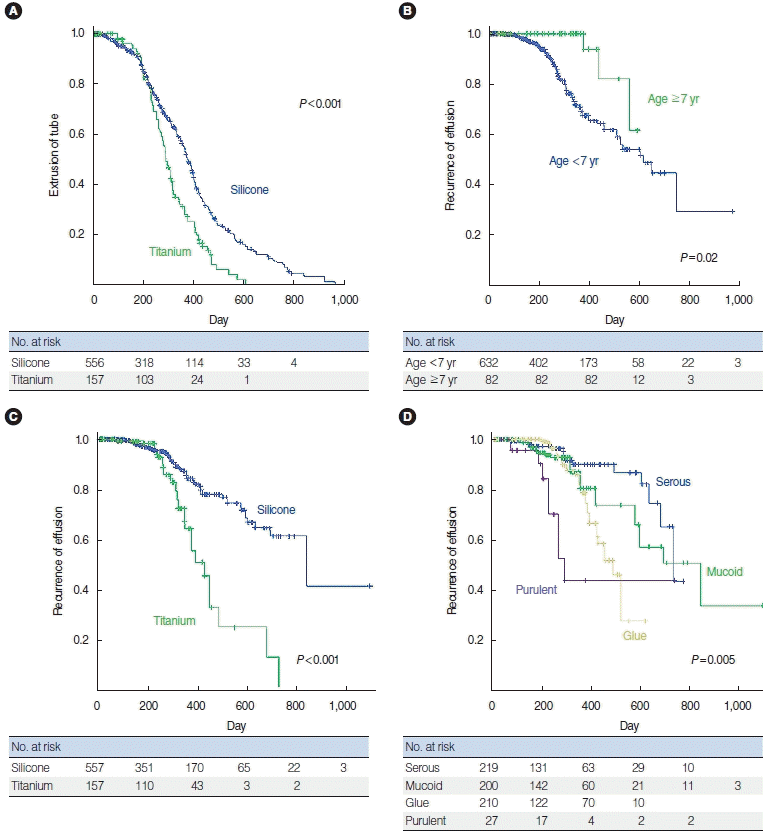Abstract
Objectives
Methods
Results
Notes
AUTHOR CONTRIBUTIONS
Conceptualization: JC, JWC, HJP, KYL. Data curation: MHY, YSC, JC, JHC, GCH, BCJ, ISM, SHL, JR, SGY. Formal analysis: MHY, JC, JWC, KYL, JHS. Funding acquisition: YSC, YHC, JWC, JHL, SGY. Methodology: MHY, JHC, GCH, BCJ, DKK. Project administration: MHY, JC, JWC, GCH, SHL. Visualization: MHY, BCJ, DKK, KSK, JHL, ISM, HJP, SNP, JHS, SGY. Writing–original draft: MHY, JWC. Writing–review & editing: YSC, JC, YHC, JHC, JWC, GCH, BCJ, DKK, KSK, JHL, KYL, SHL, ISM, HJP, SNP, JR, JHS, SGY.
ACKNOWLEDGMENTS
SUPPLEMENTARY MATERIALS
Supplementary Table 1.
Supplementary Table 2.
Supplementary Table 4.
Supplementary Table 5.
Supplementary Table 6.
Supplementary Table 7.
REFERENCES
Fig. 1.

Table 1.
Table 2.
| Variable |
Time to extrusion (day) |
Time to recurrence (day) |
||||
|---|---|---|---|---|---|---|
| Mean (95% CI) | P-value | VT extruded ears/total ears | Mean (95% CI) | P-value | Effusion recurrence ears/total ears | |
| Age (yr) | 0.043* | 0.002* | ||||
| <7 | 373 (352–393) | 345/631 | 868 (763–972) | 87/631 | ||
| ≥7 | 421 (373–470) | 46/82 | 785 (727–843) | 3/82 | ||
| Tube material | <0.001* | <0.001* | ||||
| Silicone | 400 (377–423) | 286/556 | 973 (850–1,096) | 58/556 | ||
| Titanium | 312 (291–334) | 105/157 | 558 (480–636) | 32/157 | ||
| Ear | 0.340 | 0.522 | ||||
| Left | 387 (360–413) | 194/369 | 925 (805–1,046) | 48/369 | ||
| Right | 369 (343–393) | 197/344 | 879 (742–1,017) | 42/344 | ||
| Sex | 0.538 | 0.242 | ||||
| Male | 384 (358–409) | 242/430 | 812 (755–869) | 54/430 | ||
| Female | 369 (343–394) | 149/283 | 895 (759–1,031) | 36/283 | ||
| Preoperative antibiotics | 0.309 | 0.259 | ||||
| Used | 357 (324–389) | 98/171 | 739 (640–867) | 25/171 | ||
| Not used | 382 (359–404) | 283/520 | 952 (855–1,049) | 65/520 | ||
| Revision case | 0.097 | 0.148 | ||||
| Initial | 387 (366–409) | 311/558 | 821 (771–871) | 68/558 | ||
| Revision | 346 (306–386) | 76/145 | 801 (634–969) | 22/145 | ||
| Preoperative hearing | 0.378 | 0.520 | ||||
| Good hearing | 381 (332–431) | 56/97 | 845 (772–916) | 9/97 | ||
| Poor hearing | 346 (313–379) | 97/176 | 804 (735–872) | 18/176 | ||
| Effusion composition | 0.600 | <0.001* | ||||
| Serous | 393 (358–428) | 113/218 | 846 (793–900) | 15/218 | ||
| Mucoid | 357 (325–389) | 118/200 | 926 (778–1,073) | 25/200 | ||
| Glue | 375 (348–402) | 111/210 | 588 (543–633) | 32/210 | ||
| Purulent | 364 (234–495) | 18/27 | 567 (395–740) | 8/27 | ||
| Bacterial growth in culture | 0.111 | 0.680 | ||||
| Positive | 316 (258–373) | 24/39 | 601 (479–724) | 5/39 | ||
| Negative | 385 (356–414) | 153/288 | 748 (678–817) | 45/288 | ||
The analysis was performed after excluding ears with long-lasting tubes. Poor hearing was defined as an air-bone gap ≥20 dB or air conduction ≥30 dB.
The log-rank test using Kaplan-Meier curves was used for the statistical analysis, including mean values.
CI, confidence interval; VT, ventilation tube.
Table 3.
| Variable | Hazard ratio (95% CI) | P-value |
|---|---|---|
| VT material | ||
| Silicone | 1.746 (1.386–2.200) | <0.001* |
| Titanium | - | - |
Table 4.
| Variable | Hazard ratio (95% CI) | P-value |
|---|---|---|
| Age (yr) | ||
| <7 | - | - |
| ≥7 | 3.949 (1.239–12.590) | 0.020* |
| VT material | ||
| Silicone | 2.117 (1.254–3.572) | 0.005* |
| Titanium | - | - |
| Effusion status | - | 0.005* |
| Serous | - | - |
| Mucoid | 1.796 (0.940–3.433) | 0.076 |
| Glue | 2.138 (1.115–4.096) | 0.022* |
| Purulent | 4.664 (1.957–11.115) | 0.001* |
Table 5.
| Variable | Serous (n=142) | Mucoid (n=148) | Glue-like (n=144) | Purulent (n=18) | P-value |
|---|---|---|---|---|---|
| VT otorrhea | 2.1 (3) | 4.1 (6) | 2.1 (3) | 0 | 0.582 |
| VT plugging | 4.9 (7) | 5.4 (8) | 3.5 (5) | 11.1 (2) | 0.529 |
| Persistent perforation | 1.4 (2) | 0 | 0 | 0 | 0.223 |
| Revision VT during FU | 3.5 (5) | 15.5 (23) | 10.4 (15) | 38.9 (7) | <0.001* |




 PDF
PDF Citation
Citation Print
Print



 XML Download
XML Download